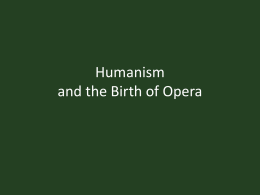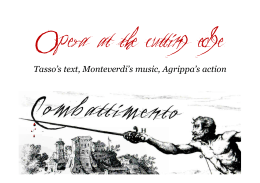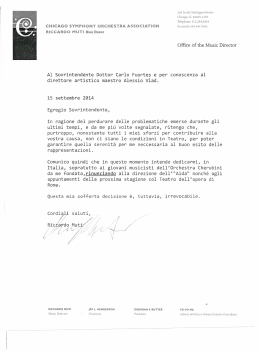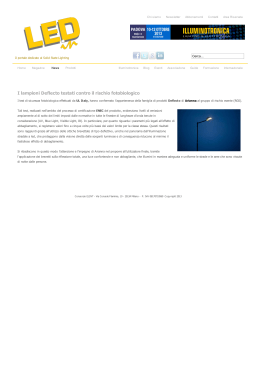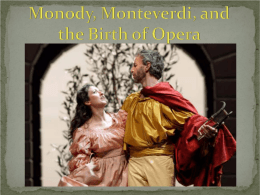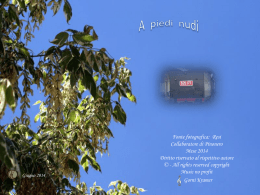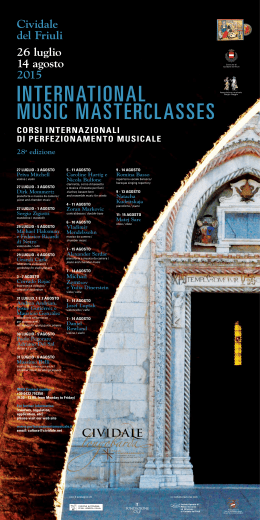ROBIN HALWAS LIMITED ● www.robinhalwas.com Rinuccini, Ottavio Florence 1562 – 1621 Florence L’Arianna tragedia… rappresentata in musica nelle Reali Nozze del Sereniss. Principe di Mantova, e della Serenissima Infanta di Savoia. Mantua, Heirs of Francesco Osanna, 1608 (218 × 455 mm), (26)ff. signed π2 A–F4 (blank F4) and paginated (4) 1–46 (2). Woodcut (insignia of the dukes of Mantova and Monferrato) on title-page, woodcut initial I (folio A1 recto), woodcut tail-piece (A1 verso, repeated F3 verso), head-pieces composed of type ornaments. QUARTO Contemporary pen corrections: p.1, line 7: ‘Non perche mortal guardo il cor m’alletti’ revised to ‘Non perche mortal guardo il cor saetti’; p.1, line 9: ‘Di strali armato, e non di face, o d’arco’ revised to ‘Di cetra armato, e non di strali, o d’arco’. 1 PROVENANCE Baron Horace de Landau (1824–1903), his exlibris (inkstamped 9733) on pastedown — anonymous consignor, Sotheby’s, ‘Libri e stampe’, Milan, 11 December 2006, lot 827 Apart from a few spots, in very good state of preservation. BINDING T nineteenth-century Italian leather-backed boards. of Arianna, set to music by Monteverdi (his second opera), and performed on 28 May 1608 in the Sala degli Specchi in the Palazzo Ducale in Mantua, as the first entertainment of extravagant festivities there celebrating the marriage of the heirapparent, Francesco III Gonzaga, to Margherita of Savoy (the formal wedding had been in Turin on 19 February). 2 Several versions of Arianna’s lament, ‘Lasciatemi morire’, are known, the only music from the opera to survive. 3 HE LIBRETTO 1 Exlibris reproduced by Egisto Bragaglia, Gli ex libris italiani: dalle origini alla fine dell’Ottocento (Milan 1993), no. 2036. The copy is not entered in Fr. Roediger, Catalogue des livres manuscrits et imprimés composant la bibliothèque de M. Horace de Landau (Florence 1885–1890), unless contained within the ‘recueil factice de libretti des XVII et XVIIIe siècles que nous avons réuni et qui comprend plus de 500 pièces’ (I, p.237). 2 Jessica Gordon, ‘Entertainments for the marriages of the princesses of Savoy in 1608’ in Italian Renaissance festivals and their European influence, edited by J.R. Mulryne and Margaret Shewring (Lewiston 1992), pp.119–140. 3 Printed in Monteverdi’s Il sesto libro de madrigali a cinque voci (Venice 1614), the first of his madrigalian publications to appear after the first production, and subsequently printed in a monodic version. The libretto of Monteverdi’s second opera, in its rare first edition (reduced from 218 × 455 mm) 1 ROBIN HALWAS LIMITED ● www.robinhalwas.com Arianna was immediately enshrined by contemporary theorists as an exemplar of what opera should be and of how music and poetry should relate to one another; modern scholars regard the work no less highly, but examine it in relation to contemporary rhetorical studies, coming of age rituals, and in the context of gender and sexuality. 4 Upon the success of his first opera, Orfeo, performed in Mantua during the carnival of 1607, Monteverdi was commissioned to write music for the Savoy-Gonzaga wedding. 5 Rinuccini delivered a preliminary draft of the libretto to him in October 1607, and Monteverdi evidently wrote most of the music over the following two months. Both composer and librettist were in Mantua in February 1608, where they met with the superintendent of the festivities, Federico Follino, and others. Their intention was to celebrate the wedding during the Carnival season, however in late February 1608, Monteverdi’s pupil, Caterina Martinelli, who was to take the title-role, contracted smallpox and died. 6 A replacement for her was soon found in the commedia dell’arte actress Virginia Andreini, and a successful rehearsal of the entire work was conducted on 15 March. 7 Rinuccini returned to Mantua in April 1608, apparently to supervise staging, and possibly to supervise the printing of L’Arianna’s libretto and make any lastminute changes requested by the composer. The wedding ceremonies however were repeatedly postponed because of diplomatic difficulties. When the bride arrived in Mantua on 24 May 1608, the festivities began immediately. They also featured a performance of L’Idropica, a comedy by Battista Guarini with intermedi written by Gabriello Chiabrera, and a ‘Ballo delle ingrate’. This is the first edition of the libretto, printed ‘Presso gli Heredi di Francesco Osanna Stampator Ducale’, and very probably distributed before the performance, functioning as advertising for it and as an aid to following the action on stage. Certain readings in the The corrected readings (in pen and ink) are printed in later editions 4 The extensive secondary literature is discussed in Suzanne G. Cusick, ‘“There was not one lady who failed to shed a tear”: Arianna’s lament and the construction of modern womanhood’ in Early music 22 (1994), pp.21–41; see further, essays by Tim Carter, Anne MacNeil, and Suzanne Cusick in Early music 27 (1999); and Anne MacNeil, Music and women of the Commedia dell’Arte in the late sixteenth century (Oxford 2003). 5 For an account of the events surrounding the creation of the opera, see Paolo Fabbri, Monteverdi, translated by Tim Carter (Cambridge 1994), pp.77–99. 6 Edmond Strainchamps, ‘The Life and Death of Caterina Martinelli: New Light on Monteverdi’s Arianna’ in Early Music History 5 (1993), pp.155–186. 7 Paoloa Besuitt, ‘The “Sala degli Specchi” uncovered: Monteverdi, the Gonzagas and the Palazzo Ducale, Mantua’ in Early Music 27 (1999), p.460, with a new dating (15 March 1608) and full transcription of a letter from Antonio Costantini to Duke Vincenzo Gonzaga concerning this rehearsal. 2 ROBIN HALWAS LIMITED ● www.robinhalwas.com prologue – stressing the importance of the house of Savoy at the expense of the Gonzagas, referring to the bride’s father, Carlo Emmanuele I, as ‘Carlo immortal’ – suggest that it was printed at the expense of the Savoyards. 8 Two copies of the edition are located in North American libraries A second edition, presenting the text actually heard at the performance (substituting references to the bride for those to her father), including stage directions, occurs within Federico Follino’s commemorative account of the wedding festivities, printed by ‘Aurelio, & Lodovico Osanna Stampatori Ducal’ (i.e. after the transfer of Francesco’s press to those heirs) with a dedication dated 1 July 1608. 9 Further reprints of the libretto at Florence 10 and Venice 11 appeared the same year (the ‘Carlo immortal’ readings are printed in these editions). and twelve copies are reported in European libraries Until recently, scholars were unaware of the textual differences in the sources, and the text generally relied upon was Follino’s second edition, derived moreover not from the original, but from an inaccurate transcription first published in 1904 by Angelo Solerti. 12 Only within the last ten years has the text offered in our first edition begun to be studied, an undertaking complicated by its relative inaccessibility (there is no published transcription or facsimile). ● Chicago, Newberry Library, Y712.R469 ● Washington, DC, Library of Congress 13 ● Florence, Biblioteca Marucelliana (located by Sartori) ● Florence, Biblioteca nazionale centrale 14 ● The Hague, Nederlands Muziek Instituut, NMI 4H51 (Collectie Dr. H.F. Scheurleer) ● Modena, Biblioteca Estense (located by Sartori) ● Paris, Bibliothèque de l'Arsenal 15 ● Paris, Bibliothèque nationale de France, YD–1565 16 ● Rome, Biblioteca del Conservatoria di Musica S. Cecilia (located by Sartori) ● Reggio Emilia, Biblioteca Municipale Panizzi (located by Sartori) ● Turin, Biblioteca Civica Musicale ‘Andrea Della Corte’ (located by Sartori) ● Turin, Biblioteca centrale della Facoltà di lettere e filosofia dell’Università degli studi di Torino, RMLE01023 ● Venice, Biblioteca Conservatorio (located by Sartori) ● Venice, Biblioteca Marciana, Marc. Dramm. 2985 17 REFERENCE Claudio Sartori, I libretti italiani a stampa dalle origini al 1800: catalogo analitico (Cuneo 1990), no. 2549 The first edition is rare: no other copy has appeared in the auction salerooms for at least fifty years, and the book is thus absent in several of the expected repositories (including British Library, Pierpont Morgan Library, and New York Public Library). 8 Bojan Bujic, ‘Rinuccini the craftsman: A view of his L’Arianna’ in Early Music History 18 (1999), pp.75–117, especially pp.78–79; Anne MacNeil, ‘Weeping at the Water’s Edge’ in Early Music 27 (1999), p.413; Anne MacNeil, Music and women of the Commedia dell’Arte in the late sixteenth century (Oxford 2003), p.156. 9 Compendio delle sontuose feste fatte l’anno MDCVIII nella città di Mantova (Mantua 1608), pp.31–65. A facsimile of this extremely rare book has now been published, in Cronache Mantovane 1587–1608, edited by Claudio Gallico (Florence 2004), pp.103–257. 10 L’Arianna. Tragedia del sig. Ottavio Rinuccini (Florence: Giunti, 1608); see I Giunti tipografi editori di Firenze, 1571–1625: annali inediti, edited by Luigi Silvestro Camerini (Florence 1979), p.152; J. Rigbie Turner, Four centuries of opera: manuscripts and printed editions in the Pierpont Morgan Library (New York 1983), pp.7–9; ‘Per un regale evento’: spettacoli nuziali e opera in musica alla corte dei Medici, catalogue of an exhibition held in the Biblioteca nazionale centrale, edited by Maria Adelaide Bartoli Bacherini (Florence 2000), p.171 no. 5. 11 L’Arianna. Tragedia del sig. Ottavio Rinuccini (Venice: Giunti, Ciotti & compagni, 1608); see Le edizioni veneziane del Seicento: censimento, edited by Caterina Griffante (Milan 2006), no. 452 (and nos. 453–455 for reprints there in 1622, 1639, 1640). 12 Angelo Solerti, Gli arbori del melodramma (Milan 1904), II, pp.143–187. 13 Oscar Sonneck Catalogue of Opera Librettos printed before 1800 [in Library of Congress] (Washington, DC 1914), p.140. 14 Title-page reproduced by Claudia Burattelli, Spettacoli di corte a Mantova tra Cinque e Seicento (Florence 1999), fig. 17. 15 La vie théâtrale au temps de la renaissance, catalogue of an exhibition, Institut pédagogique national (France), March-May 1963 (Paris 1963), p.184 no. 354. 16 Suzanne P. Michel and Paul Henri Michel, Répertoire des ouvrages imprimés en langue italienne au XVIIe siècle conservés dans les bibliothèques de France (Paris 1967–1984), VII, p.33. 17 Annalisa Bruni, ‘Claudio Monteverdi. Mostra bibliografica’ [in Libreria Sansoviniana, 27 November–12 December 1993] in Miscellanea Marciana 7–9 (1992–1994), p.482, no. 27. 3
Scarica
